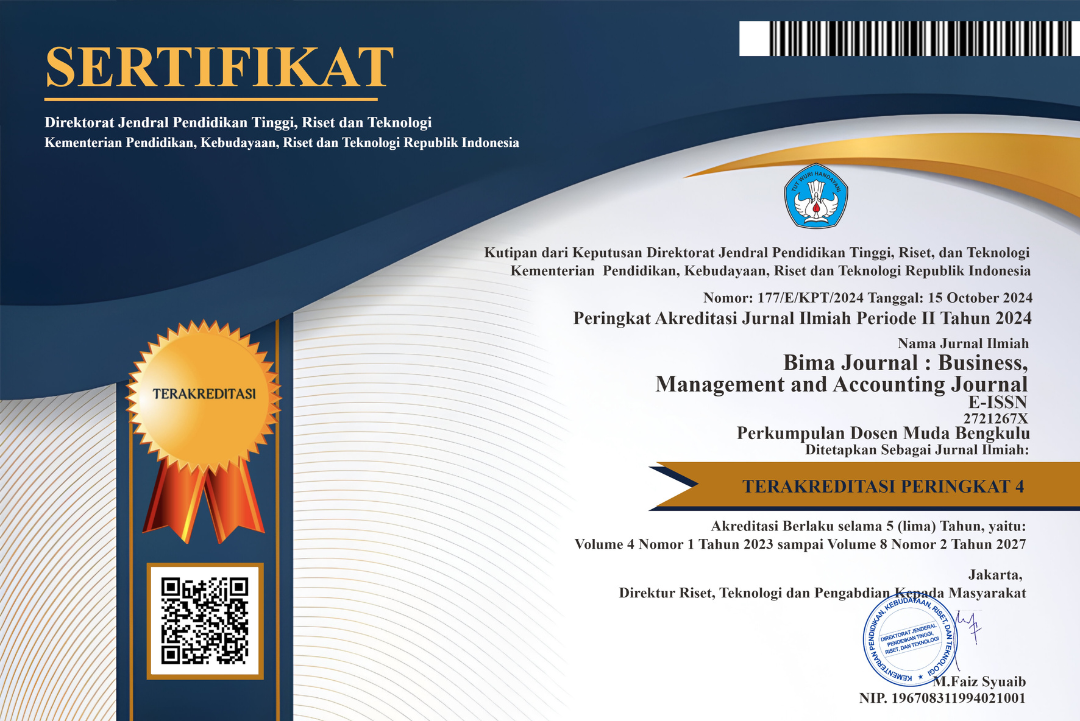Influence of Opportunities and Challenges on the Success of Young Entrepreneurs with Social Media Marketing Moderation Variables
DOI:
https://doi.org/10.37638/bima.5.2.207-218Keywords:
Opportunities, Challenges, Success of Young Entrepreneurs, Social Media MarketingAbstract
Purpose: This study aims to analyze the influence of Opportunities and Challenges on the Success of Young Entrepreneurs and examine the moderating role of Social Media Marketing in this relationship, focusing on café and restaurant businesses in Limapuluh Kota Regency and Payakumbuh City. Methodology: The research employs SEM PLS analysis using the SmartPLS 3.0 tool. Primary data were collected from 61 millennial café and restaurant business owners via a Likert scale-based questionnaire distributed through Google Forms. Results: Opportunities (X1) and Challenges (X2) have a positive and significant effect on the Success of Young Entrepreneurs (Y). Social Media Marketing (Z) positively and significantly moderates the relationship between Opportunities (X1), Challenges (X2), and Young Entrepreneur Success (Y). Findings: Effective Social Media Marketing amplifies the impact of Opportunities and Challenges on the success of young entrepreneurs in the café and restaurant sector. Originality: This study provides fresh insights into the role of digital marketing strategies in enhancing entrepreneurial success in a competitive business environment. Novelty: It integrates Social Media Marketing as a key moderating factor in the entrepreneurial framework of young business owners. Conclusions: Utilizing social media marketing is crucial for young entrepreneurs to achieve sustainable growth and competitiveness. Type of Paper: Empirical research paper.
References
Ahmad Wani, T., & Wajid Ali, S. (2015). Innovation Difusion heory Review & Scope in the Study of Adoption of Smartphones in India. Journal of General Management Research, 3(2).
Al-Amin, A.-A., Alfia, N., Subeno, H., Andespa, W., & Sabri, S. (2023). The Effect of Claim Service Quality on the Decision to Buy Sharia Insurance Products (Case study on Sharia Insurance in Indonesia). GIC Proceeding, 1, 396–407.
Al-Amin, A.-A., & Andespa, W. (2022). Income and Cost Analysis of Profitability in the Baitul Maal Wa Tamwil Sidogiri Savings and Loans Cooperative, Mempawah Branch. JOVISHE: Journal of Visionary Sharia Economy, 1(1), 75–87.
Alifuddin, M., & Razak, M. (2015). Kewirausaan Teori dan Aplikasi. MAGNAScript.
Alimuddin, M., & Poddala, P. (2023). Prospek Digital Marketing Untuk Generasi Muda Dalam Berwirausaha. Journal of Career Development, 1(1), 54–70.
Alma, B., & Juni, P. D. (2009). Manajemen Bisnis Syariah Bandung: Alfabeta.
Amin, A.-A., & Taufiq, M. M. (2023). Analisis Pengaruh Hifdz Al Maal Terhadap Pengelolaan Harta Pada Pedagang Muslim Pasar Aur Kuning Kota Bukittinggi. JESI (Jurnal Ekonomi Syariah Indonesia), 12(2), 163–169.
Appel, G., Grewal, L., Hadi, R., & Stephen, A. T. (2020). The future of social media in marketing. Journal of the Academy of Marketing Science, 48(1), 79–95.
Aruni, S. F., & Hidayat, R. (2019). Psikologi Peluang Kewirausahaan: Proses Kognitif Pengusaha Startup Digital dalam Opportunity Recognition. Jurnal Psikologi, 46(1), 45. https://doi.org/10.22146/jpsi.34608
Baron, R. A. (2004). OPPORTUNITY RECOGNITION: A COGNITIVE PERSPECTIVE. Academy of Management Proceedings, 2004(1), A1–A6.
Bastian, I. (2016). Strategi Manajemen Sektor Publik. Jakarta: Salemba Empat.
Cant, G. (2009). Developing a framework of success of Bumiputera entrepreneurs. Journal of Enterprising Communities: People and Places in the Global Economy, 3(1), 8–24.
https://doi.org/10.1108/17506200910943652
Chang, Y. Y. (2020). Creative entrepreneurs’ creativity, opportunity recognition, and career success: Is resource availability a double-edged sword? European Management Journal, 38(5), 750–762. https://doi.org/10.1016/j.emj.2020.03.004
Chimucheka, T. (2012). Impediments to youth entrepreneurship in rural areas of Zimbabwe. African Journal of Business Management, 6(38), 10389–10395. https://doi.org/10.5897/AJBM12.790
Cueto, L. J., Frisnedi, A. F. D., Collera, R. B., Batac, K. I. T., & Agaton, C. B. (2022). Digital Innovations in MSMEs during Economic Disruptions: Experiences and Challenges of Young Entrepreneurs. Administrative Sciences, 12(1). https://doi.org/10.3390/admsci12010008
Fachrurazi. (2021). Kewirausahaan (Teori dan Praktek). (Yulida (Ed.); Issue September).
Farida, N. E. A. (2022). Kewirausahaan. CV Rey Media Grafika.
Hao, X., Rosak-szyrocka, J., & Vasa, L. (2023). Obsessive passion , opportunity recognition , and entrepreneurial performance : The dual moderating effect of the fear of failure. January, 1–14. https://doi.org/10.3389/fpsyg.2022.1037250
Indonesia Millennial Report. (2022). IDN Research Institute.
Khatib, F. (2016). The impact of social media characteristics on purchase decision empirical study of Saudi customers in Aseer Region. International Journal of Business and Social Science, 7(4), 41–50
Kurniawan, G. (2019). Kewirausahaan Di Era 4.0. Sasanti Institute.
Lestari, F. (2020). Pengaruh Jiwa Kewirausahaan dan Kreativitas Terhadap Keberhasilan Usaha pada Sentra Industri Rajutan Binong Jati Bandung. Jurnal Ilmiah, 14–15.
Lukes, M., & Laguna, M. (2010). Entrepreneurhip A Psychological Approach. Entrepreneurship A Psychological Approach.
Mani, M. (2013). Motivation, Challenges and Success Factors of Entrepreneurs: An Empirical Analysis. Pertanika Journal of Social Sciences and Humanities, 21(2), 667–676.
Maulida, S., & Yunani, A. (2017). Peluang dan Tantangan Pengembangan Usaha Mikro Kecil Menengah (UMKM) Dari Berbagai Aspek Ekonomi. Jurnal Ilmiah Manajemen Dan Bisnis, 2(1), 181–197.
Noor, Y. M. (2022). The Challenges and Strategies in Sustaining a Business Among Young. Academy of Entrepreneurship Journa, 27(January).
Novita, D., & Wulandari, S. (2022). Pengaruh Media Sosial Terhadap peluang Usaha Warga RT 04 RW 08 Kelurahan Tugu Depok. Journal of Applied Business and Economic (JABE), 8(4), 398–413.
Olugbola, S. A. (2017). Journal of Innovation Exploring entrepreneurial readiness of youth and startup success components : Entrepreneurship. Suma de Negocios, 2(3), 155–171. https://doi.org/10.1016/j.jik.2016.12.004
Porter, M. E. (2020). Techniques for Analyzing. In Techniques for Analyzing. https://doi.org/10.1201/9781003067573
Purwana, D., Rahmi, R., & Aditya, S. (2017). Pemanfaatan digital marketing bagi usaha mikro, kecil, dan menengah (UMKM) di Kelurahan Malaka Sari, Duren Sawit. Jurnal Pemberdayaan Masyarakat Madani (JPMM), 1(1), 1–17.
Rogers, E. M. (2010). Diffusion of innovations. Simon and Schuster.
Shane, S. (2000). Prior knowledge and the discovery of entrepreneurial opportunities. Organization Science, 11(4), 448–469.
Sundari Cisilia. (2019). Tantangan Bisnis Bagi Generasi Milenial. Prosiding Seminar Nasional Fakultas Ekonomi Untidar, Revolusi Industri 4.0 Merupakan Peluang Dan Tantangan Bisnis Bagi Generasi Milenial Di Indonesia, 555–563.
Tarmudji, T. (1996). Prinsip-prinsip wirausaha. Yogyakarta: Liberty.
Wheelen, T. L. (2011). Concepts in strategic management and business policy. Pearson Education India.
Zhang, Z., & Xing, Y. (2013). Impact of entrepreneurial orientation and risk sharing on organizational performance influencing role of news media and public opinion.
Downloads
Published
Issue
Section
License
An author who publishes in the BIMA JOURNAL: Business, Management, and Accounting Journal agrees to the following terms:
Author retains the copyright and grants the journal the right of first publication of the work simultaneously licensed under the Creative Commons Attribution-ShareAlike 4.0 License that allows others to share the work with an acknowledgement of the work's authorship and initial publication in this journal
Submission of a manuscript implies that the submitted work has not been published before (except as part of a thesis or report, or abstract); that it is not under consideration for publication elsewhere; that its publication has been approved by all co-authors. If and when the manuscript is accepted for publication, the author(s) still hold the copyright and retain publishing rights without restrictions. For the new invention, authors are suggested to manage its patent before published. The license type is CC-BY-SA 4.0.
BIMA JOURNAL: Business, Management and Accounting is licensed under a Creative Commons Attribution-ShareAlike 4.0 International License.
You are free to:
Share — copy and redistribute the material in any medium or format
Adapt — remix, transform, and build upon the material
for any purpose, even commercially.
The licensor cannot revoke these freedoms as long as you follow the license terms.
Under the following terms:
Attribution — You must give appropriate credit, provide a link to the license, and indicate if changes were made. You may do so in any reasonable manner, but not in any way that suggests the licensor endorses you or your use.
ShareAlike — If you remix, transform, or build upon the material, you must distribute your contributions under the same license as the original.
- No additional restrictions — You may not apply legal terms or technological measures that legally restrict others from doing anything the license permits.
Notices:
- You do not have to comply with the license for elements of the material in the public domain or where your use is permitted by an applicable exception or limitation.
- No warranties are given. The license may not give you all of the permissions necessary for your intended use. For example, other rights such as publicity, privacy, or moral rights may limit how you use the material.





















